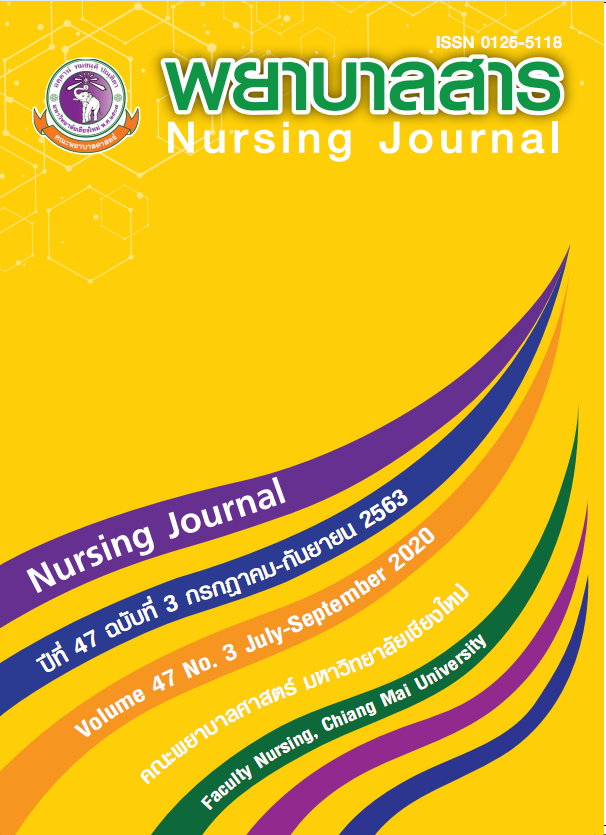Anticipatory Grief and Coping Among Parents with Children Transitioning into Palliative Care in Critical Care Units
Keywords:
parents with children, palliative care, critical care unit, anticipatory grief, copingAbstract
เด็กป่วยจำนวนมากที่เข้ารับการรักษาในหอผู้ป่วยวิกฤตกุมารเวชกรรมได้ถูกปรับเปลี่ยนรูปแบบและเป้าหมายการดูแลจากการรักษาให้หายขาดไปเป็นการดูแลแบบประคับประคอง เด็กป่วยและครอบครัวจึงอยู่ท่ามกลางความรู้สึกของความไม่แน่นอน โดยเฉพาะบิดามารดาจะมีความรู้สึกโศกเศร้าก่อนที่จะเกิดการสูญเสีย และใช้กลวิธีต่างๆในการเผชิญต่อการสูญเสียบุตรที่จะต้องเกิดขึ้น การวิจัยนี้เป็นการวิจัยเชิงพรรณนา มีวัตถุประสงค์เพื่อศึกษาความโศกเศร้าก่อนที่จะเกิดการสูญเสีย และกลวิธีการเผชิญของบิดามารดาที่มีบุตรเข้าสู่ระยะการดูแลแบบประคับประคองในหอผู้ป่วยวิกฤต กลุ่มตัวอย่างเป็นบิดามารดาที่มีบุตรอายุ 1 ถึง 15 ปี ที่เข้าสู่ระยะการดูแลแบบประคับประคองในหอผู้ป่วยวิกฤต โรงพยาบาลระดับตติยภูมิในเขตภาคเหนือ จำนวน 102 ราย ตั้งแต่เดือนตุลาคม พ.ศ. 2559 ถึงเดือนพฤษภาคม พ.ศ. 2560 เครื่องมือที่ใช้ในการเก็บรวบรวมข้อมูล ได้แก่ แบบสอบถามข้อมูลทั่วไป แบบประเมินความรู้สึกของบิดามารดาที่มีบุตรเข้าสู่ระยะการดูแลแบบประคับประคอง (ค่าความเชื่อมั่นเท่ากับ .82) และแบบประเมินกลวิธีการเผชิญของบิดามารดาที่มีบุตรเข้าสู่ระยะการดูแลแบบประคับประคอง (ค่าความเชื่อมั่น เท่ากับ .83) วิเคราะห์ข้อมูลโดยใช้สถิติพรรณนา ผลการวิจัยพบว่า
- 1. บิดามารดาที่มีบุตรเข้าสู่ระยะการดูแลแบบประคับประคองในหอผู้ป่วยวิกฤตส่วนมากมีความโศกเศร้าก่อนที่จะเกิดการสูญเสียอยู่ในระดับมาก (Mean=92.21, SD=3.91) โดยมีการแสดงออกถึงความโศกเศร้าก่อนที่จะเกิดการสูญเสียมากที่สุด 5 อันดับแรก ได้แก่ การเฝ้านึกถึงภาพของบุตรเมื่อครั้งที่ยังไม่เจ็บป่วย (Mean=4.27, SD=0.75) การมีความรู้สึกใกล้ชิดหรือสนิทกับบุตรมากขึ้น (Mean=4.16, SD=0.99) การวาดฝันถึงภาพชีวิตตัวเองกับบุตรเมื่อครั้งก่อนที่บุตรจะเจ็บป่วย (Mean=4.06, SD=1.09) การนอนไม่หลับหลังจากที่ทราบผลการวินิจฉัยโรคของบุตร (Mean=3.88, SD=0.92) และการคิดล่วงหน้าไปเองเกี่ยวกับการเจ็บป่วยของบุตร (Mean=3.86, SD=0.86)
2.บิดามารดาที่มีบุตรเข้าสู่ระยะการดูแลแบบประคับประคองในหอผู้ป่วยวิกฤตใช้กลวิธีการเผชิญทั้ง
3 วิธี โดยใช้กลวิธีด้านการเผชิญหน้ากับปัญหา และด้านการจัดการกับปัญหาทางอ้อมมากที่สุด (คะแนนสัมพัทธ์=.39) และใช้กลวิธีด้านการจัดการกับอารมณ์น้อยที่สุด (คะแนนสัมพัทธ์=.22) และบิดามารดาเลือกใช้วิธีการเผชิญในแต่ละด้านมากที่สุด 3 อันดับแรก ดังนี้
ด้านการเผชิญหน้ากับปัญหา คือ การพยายามอย่างมากที่จะทำให้บุตรมีอาการดีขึ้นหรือหายจากการเจ็บป่วย (Mean=4.44, SD=0.78) การพยายามหาข้อมูลเพิ่มเติมเกี่ยวกับความเจ็บป่วยของบุตรเพื่อให้สามารถจัดการกับปัญหาได้ดีขึ้น (Mean=4.06, SD=0.96) และการพยายามค้นหาเป้าหมายของการดูแลรักษาบุตร หรือทำความเข้าใจเกี่ยวกับสถานการณ์ความเจ็บป่วยของบุตร (Mean=3.99, SD=1.11)
ด้านการจัดการกับปัญหาทางอ้อม คือ การสวดมนต์ ขอพรจากสิ่งศักดิ์สิทธิ์ (Mean=4.53, SD=0.70) การมีความหวังว่าความเจ็บป่วยของบุตรในครั้งนี้จะดีขึ้น (Mean=4.52, SD=0.73) และการพยายามทำบางสิ่งบางอย่างที่คิดว่าจะช่วยให้บุตรมีอาการดีขึ้น หรือหายจากโรค ทั้งๆที่ไม่แน่ใจว่าจะช่วยได้หรือไม่ (Mean=4.31, SD=0.83)
ด้านการจัดการกับอารมณ์ คือ ความรู้สึกกังวลใจเกี่ยวกับความเจ็บป่วยของบุตร (Mean=4.32, SD=0.83) การคิดฝันว่าบุตรจะมีอาการดีขึ้นทั้งๆที่ยังไม่ได้เป็นเช่นนั้น (Mean=4.21, SD=0.88) และความรู้สึกกระวนกระวาย ว้าวุ่นใจ (Mean=3.76, SD=1.00)
ผลการวิจัยครั้งนี้สามารถนำไปใช้ในการพัฒนาระบบการดูแลแบบประคับประคองในหอผู้ป่วยวิกฤตกุมารเวชกรรมให้มีประสิทธิภาพยิ่งขึ้น โดยจัดทีมการดูแลแบบประคับประคองเป็นแบบทีมเจ้าของไข้ที่ให้การดูแลผู้ป่วยเด็กและครอบครัวอย่างต่อเนื่อง มีการให้ข้อมูลการเจ็บป่วยของบุตร ให้การสนับสนุนช่วยเหลือทางด้านจิตใจ เปิดโอกาสให้ได้ระบายความรู้สึก และจัดสถานที่ที่เอื้อต่อการปฏิบัติตามความเชื่อและศาสนาของบิดามารดาแต่ละราย ทั้งนี้เพื่อช่วยให้บิดามารดาที่มีบุตรเข้าสู่ระยะการดูแลแบบประคับประคองในหอผู้ป่วยวิกฤตสามารถเผชิญกับสถานการณ์ได้อย่างเหมาะสม
References
Al-Gamal, E., & Long, T. (2010). Anticipatory grieving among parents living with a child with cancer.Journal of Advanced Nursing, 66 (9), 1980-1990. doi:10.1111/j.1365-2648.2010.05381.
Chambers, L., Dodd, W., McCulloch, R., McNamara-Goodger, K., Th ompson, A., Widdas, D. A., & Johnson, M. (2009). A guide to the development of children’s palliative care services. Bristol: Association for Children’s Palliative Care.
Denis-Larocque, G., Williams, K., St-Sauveur, I., Ruddy, M., & Rennick, J. (2017). Nurses' perceptions of caring for parents of children with chronic medical complexity in the pediatric intensive care unit. Intensive & critical care nursing, 43, 149–155.
Department of Mental Health. (2016). Thai Depression Inventory (TDI) 2004. Retrieved from http://www.dmh.go.th/test/depress/asheet.asp?qid=1
Futterman, E., Hoffman, I., & Sabshin, M. (1972). Parental anticipatory mourning. Psychosocial aspects of terminal care, 243-272.
Jalowiec, A. (1988). Confirmatory factor analysis of the Jalowi ec Coping Scale. Measurement of nursing outcomes, 1, 287-308.
Jalowiec, A., & Powers, M. J. (1981). Stress and coping in hypertensive and emergency room patients. Nursing Research, 30(1), 10-15.
Jee, R. A., Shepherd, J. R., Boyles, C. E., Marsh, M. J., Thomas, P. W., & Ross, O. C. (2012). Evaluation and comparison of parental needs, stressors, and coping strategies in a pediatric intensive care unit. Pediatric Critical Care Medicine, 13 (3), e166-e175.
Kenner, C., Press, J., & Ryan, D. (2015). Recommendations for p alliative and bereavement care inthe Nicu: A family-centered integrative approach. Journal of perinatology: Official journal ofthe California Perinatal Association, 35 (1), S19-23.
Krejcie, R. V., & Morgan, D. W. (1970). Determining sample size for research activities. Educational and psychological measurement, 30(3), 607-610.
Burke, L. A., & Neimeyer, R. A. (2013). 11 Prospective risk factors for complicated grief. New York: Routledge.
Lazarus, R. S., & Folkman, S. (1984). Stress, appraisal, and coping. United States: Springer.
McAdam, J. L., Fontaine, D. K., White, D. B., Dracup, K. A., & Puntillo, K. A. (2012). Psychological symptoms of family members of high-risk intensive care unit pat ients. American Journal of Critical Care, 21 (6), 386-394. doi:10.4037/ajcc2012582
Moon, P. J. (2016). Anticipatory Grief A Mere Concept?. American Journal of Hospice and Palliative Medicine, 33 (5), 417-420.
Nielsen, M. K., Neergaard, M. A., Jensen, A. B., Bro, F., & Guldin, M.-B. (2016). Do we need to change our understanding of anticipatory grief in caregivers? A systematic review of caregiver studies during end-of-life caregiving and bereavement. Clinical Psychology Review, 44, 75-93. doi: 10.10 16/j.cpr.2016.01.002
Punaglom, N., Kata, W., & Pothisarn, S. (2016). Thinking and Feeling of Northeast Thailand and Laos Parents to Losing a Child to illness while Admitted to the Nakhon Phanom Hospital. Nursing Journal of the Ministry of Public Health, 26(1), 79-92. (In Thai)
Rungkasiri, T. (2000). End-of-Life Learning Model Using Multi-sensory Edutainment Approach for Children with Terminal Cancer (Doctoral dissertation, Kasetsart University). (In Thai)
Suwanosoth, S. (2004). Uncertainty, social support, and coping strategies among parents of children with cancer (Ph.D. dissertation, Chiangmai University). (In Thai)
Wiwatkamonchai, A., Kantawang, S., & Mesukko, J. (2017). Chronic Sorrow and ManagementStrategies Among Parents of Children with Cancer Receiving Chemotherapy. Nursing Journal,44 (1), 62-73. (In Thai)
Zamanzadeh, V., Valizadeh, L., Rahiminia, E., & Kochaksaraie, F. (2013). Anticipatory grief reactions in fathers of preterm infants hospitalized in neonatal intensive care unit. J Caring Sci, 2 (1), 83-88. doi:10.5681/jcs.2013.010
Downloads
Published
How to Cite
Issue
Section
License
บทความที่ได้รับการตีพิมพ์เป็นลิขสิทธิ์ของวารสารพยาบาลสาร
ข้อความที่ปรากฏในบทความแต่ละเรื่องในวารสารวิชาการเล่มนี้เป็นความคิดเห็นส่วนตัวของผู้เขียนแต่ละท่านไม่เกี่ยวข้องกับมหาวิทยาลัยเชียงใหม่ และคณาจารย์ท่านอื่นๆในมหาวิทยาลัยฯ แต่อย่างใด ความรับผิดชอบองค์ประกอบทั้งหมดของบทความแต่ละเรื่องเป็นของผู้เขียนแต่ละท่าน หากมีความผิดพลาดใด ๆ ผู้เขียนแต่ละท่านจะรับผิดชอบบทความของตนเองแต่ผู้เดียว






